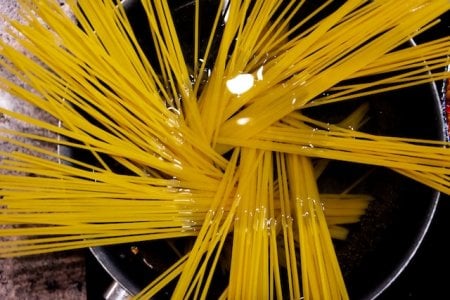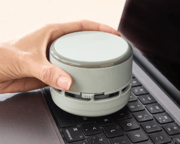Unlock the secret to delicious veggies using this pasta water tip!
By
Seia Ibanez
- Replies 11
In the world of cooking, certain secrets give your dishes an edge that puts your culinary creations a cut above the rest.
Pasta water, the humble by-product of your spaghetti dinner, is one of the culinary secret weapons hiding in plain sight.
This starchy, well-seasoned liquid is a treasure trove of flavour, and it's time we put it to good use beyond just cooking pasta.
One of the most ingenious and underrated ways to utilise this is to cook vegetables in it.
This method not only imparts a rich flavour to your veggies but also helps them achieve a delightful crispness.
The beauty of this tip lies in its simplicity and versatility. It works exceptionally well with a wide range of in-season produce, allowing you to prepare them minimally while maximising their natural flavours.
Plus, reusing pasta water is a step towards achieving the much-desired one-pot dinner, making your weeknight cooking less of a chore.
Blanching is briefly cooking something in rapidly boiling water, followed by a quick dip in an ice bath to get vibrant vegetables.
But which veggies are the best candidates for this pasta water treatment?
As a rule of thumb, hearty, crunchy vegetables and bitter greens are your best bet.
Spring asparagus and pea shoots, summer corn and green beans, fall turnips and cauliflower, and early-winter broccoli rabe all take well to this method.
The key is to let the pasta water do its magic without overpowering the freshness of your in-season produce. Consider dropping a clove or two of smashed garlic into your pasta water for an added flavour punch.
To get the best results, opt for a large pot to cook your pasta and vegetables.
This aligns with the 'big-pot blanching' method popularised by renowned chef Thomas Keller, which advocates for ample room for the vegetables to cook for the best taste.
While vegetables cooked in seasoned pasta water are delectable on their own, you can elevate their flavour profile by sautéing them in olive oil or butter with garlic, salt and pepper, and lemon zest.
Since the veggies are already cooked, they only need a minute or two in the pan to soak up these additional flavours.
When you're ready to serve, combine your vegetables and pasta in one pot, squeeze some lemon juice over the mix, and add a dab of butter for good measure. And don't forget to keep that pasta water on hand!
Adding a splash or two to the pot will help all those delicious flavours adhere to your pasta strands.
The pasta water tip is more than just a cooking tip; it's a testament to the resourcefulness and creativity that can be found in the kitchen. Using pasta water to cook vegetables is rooted in maximising flavour and minimising waste.
Moreover, this tip aligns with the growing trend of sustainable cooking. By reusing pasta water, we're reducing kitchen waste and making the most of the resources at hand. It's a small step towards a more sustainable kitchen, but every little bit counts.
Suddenly craving pasta? Why not try this Spaghetti Aglio e Olio recipe posted by one of our SDC members? It takes only seven ingredients and less than 20 minutes to make. Check out the recipe here. Just make sure to save the pasta water for later use!
 Have you tried this pasta water tip? Share your experiences and favourite vegetable-pasta combinations in the comments below!
Have you tried this pasta water tip? Share your experiences and favourite vegetable-pasta combinations in the comments below!
Pasta water, the humble by-product of your spaghetti dinner, is one of the culinary secret weapons hiding in plain sight.
This starchy, well-seasoned liquid is a treasure trove of flavour, and it's time we put it to good use beyond just cooking pasta.
One of the most ingenious and underrated ways to utilise this is to cook vegetables in it.
This method not only imparts a rich flavour to your veggies but also helps them achieve a delightful crispness.
The beauty of this tip lies in its simplicity and versatility. It works exceptionally well with a wide range of in-season produce, allowing you to prepare them minimally while maximising their natural flavours.
Plus, reusing pasta water is a step towards achieving the much-desired one-pot dinner, making your weeknight cooking less of a chore.
Blanching is briefly cooking something in rapidly boiling water, followed by a quick dip in an ice bath to get vibrant vegetables.
But which veggies are the best candidates for this pasta water treatment?
As a rule of thumb, hearty, crunchy vegetables and bitter greens are your best bet.
Spring asparagus and pea shoots, summer corn and green beans, fall turnips and cauliflower, and early-winter broccoli rabe all take well to this method.
The key is to let the pasta water do its magic without overpowering the freshness of your in-season produce. Consider dropping a clove or two of smashed garlic into your pasta water for an added flavour punch.
To get the best results, opt for a large pot to cook your pasta and vegetables.
This aligns with the 'big-pot blanching' method popularised by renowned chef Thomas Keller, which advocates for ample room for the vegetables to cook for the best taste.
While vegetables cooked in seasoned pasta water are delectable on their own, you can elevate their flavour profile by sautéing them in olive oil or butter with garlic, salt and pepper, and lemon zest.
Since the veggies are already cooked, they only need a minute or two in the pan to soak up these additional flavours.
When you're ready to serve, combine your vegetables and pasta in one pot, squeeze some lemon juice over the mix, and add a dab of butter for good measure. And don't forget to keep that pasta water on hand!
Adding a splash or two to the pot will help all those delicious flavours adhere to your pasta strands.
The pasta water tip is more than just a cooking tip; it's a testament to the resourcefulness and creativity that can be found in the kitchen. Using pasta water to cook vegetables is rooted in maximising flavour and minimising waste.
Moreover, this tip aligns with the growing trend of sustainable cooking. By reusing pasta water, we're reducing kitchen waste and making the most of the resources at hand. It's a small step towards a more sustainable kitchen, but every little bit counts.
Suddenly craving pasta? Why not try this Spaghetti Aglio e Olio recipe posted by one of our SDC members? It takes only seven ingredients and less than 20 minutes to make. Check out the recipe here. Just make sure to save the pasta water for later use!
Key Takeaways
- Pasta water, after being used to cook pasta, can be reused to cook vegetables, providing them with added flavour and crispness.
- Some vegetables respond better to the blanching process, with hearty, crunchy vegetables and bitter greens recommended.
- Cooked vegetables can be further enhanced with a short sauté in olive oil or butter with garlic, salt and pepper, and lemon zest.
- Saving some pasta water can also benefit the pasta dishes, helping the other flavours adhere to the pasta strands.








